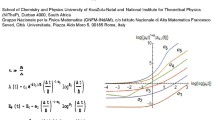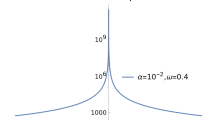Abstract
We revisit the Lee-Friedrichs model as a model of atomic resonances in the hydrogen atom, using the dipole-moment matrix-element functions which have been exactly computed by Nussenzveig. The Hamiltonian H of the model is positive and has absolutely continuous spectrum. Although the return probability amplitude \(R_{\Psi }(t) = (\Psi , \exp (-iHt) \Psi )\) of the initial state \(\Psi \), taken as the so-called Weisskopf–Wigner (W.W.) state, cannot be computed exactly, we show that it equals the sum of an exponentially decaying term and a universal correction \(O(\beta ^{2}\frac{1}{t})\), for large positive times t and small coupling constants \(\beta \), improving on some results of King (Lett Math Phys 23:215–222, 1991). The remaining, non-universal, part of the correction is also shown to be of the same qualitative type. The method consists in approximating the matrix element of the resolvent operator operator in the W.W. state by a Lorentzian distribution. No use is made of complex energies associated to analytic continuations of the resolvent operator to ”physical” Riemann sheets. Other new results are presented, in particular a physical interpretation of the corrections, and the characterization of the so-called sojourn time \(\tau _{H}(\Psi )= \int _{0}^{\infty } |R_{\Psi }(t)|^{2} dt\) as the average lifetime of the decaying state, a standard quantity in (quantum) probability.
Similar content being viewed by others
References
Aharonov, Y., Bohm, D.: Time in the quantum theory and the uncertainty relation for time and energy. Phys. Rev. 122, 1649 (1961)
Asch, J., Bourget, O., Cortés, V., Fernandez, C.: Energy-time uncertainty principle and lower bounds on sojourn time. Ann. Henri Poincaré 17, 2513 (2016)
Barut, A.O.: Quantum Electrodynamics and Quantum Optics, pp. 341-371, article by Nussenzveig in proceedings of NATO ASI series B: physics vol. 110 with title Nonperturbative theory of decaying states. Plenum Press, New York (1984)
Blanchard, P., Brüning, E.: Mathematical Methods in Physics-Distributions. Hilbert-Space Operators and Variational Methods. Birkhäuser (2003)
Benguria, R.D., Duclos, P., Fernandez, C., Sing-Long, C.: A nonlinear ordinary differential equation associated with the quantum sojourn time. J. Phys. A 43, 474007 (2010)
Brunetti, R., Fredenhagen, K.: Remarks on time-energy uncertainty relation. Rev. Math. Phys. 14, 897–906 (2002)
Bach, V., Fröhlich, J., Sigal, I.: Return to equilibrium. J. Math. Phys. 41, 3985–4060 (2000)
Brenig, W., Haag, R.: Allgemeine Quantentheorie der Stossprozesse. Fort. der Physik 7, 183–242 (1959)
Busch, P.: The time-energy uncertainty relation. In: SalaMayato, R., Muga, J.G., Egusquiza, I.L. (eds.) Time and Quantum Mechanics. Springer, New York (2002)
Davidovich, L.: On the Weisskopf Wigner approximation in atomic physics. Ph.D. thesis University of Rochester (1975)
DeRose, E., Gislason, E.A., Sabelli, N.H.: A new method for computing properties of negative ion resonances. J. Chem. Phys. 82, 4577 (1985)
Davidovich, L., Nussenzveig, H.M.: Theory of natural line shape. In: Barut, A.O. (ed.) Foundations of Radiation Theory and Quantum Electrodynamics. Plenum Press, New York (1980)
Fonda, L., Ghirardi, G.C., Rimini, A.: Decay theory of unstable quantum systems. Rep. Progr. Phys. 41, 587–631 (1978)
Friedrichs, K.: Perturbation of Spectra in Hilbert Space. American Mathematical Society, Providence (1965)
Gamow, G.: Zur Quantentheorie des Atomkernes. Z. Phys. 51, 204 (1928)
Gustafson, S., Sigal, I.M.: Mathematical Concepts in Quantum Mechanics. Springer, New York (2006)
Gislason, E.A., Sabelli, N.H., Wood, J.W.: New form of the time energy uncertainty relation. Phys. Rev. A 31, 2078 (1985)
Howland, J.S.: The Livsic matrix in perturbation theory. J. Math. Anal. Appl. 50, 415–437 (1975)
Jaksic, Vojkan: Topics in spectral theory. Lect. Notes Math. 235–312, 2006 (1880)
Katznelson, Y.: An Introduction to Harmonic Analysis. Dover Publ. Inc., New York (1976)
King, C.: Exponential decay near resonance without analyticity. Lett. Math. Phys. 23, 215–222 (1991)
Lavine, R.: Spectral density and sojourn times. In: Nuttall, J. (ed.) Atomic Scattering Theory. University of Western Ontario, London (1978)
Lee, T.D.: Some special examples in renormalizable field theory. Phys. Rev. 95, 1329 (1954)
Martin, PhA, Rothen, F.: Many Body Problems and Quantum Field Theory—An Introduction. Springer, New York (2004)
Marchetti, D.H.U., Wreszinski, W.F.: Asymptotic Time Decay in Quantum Physics. World Scientific, Singapore (2013)
Peierls, R.: Surprises in Theoretical Physics. Princeton University Press, Princeton (1979)
Pfeifer, P., Fröhlich, J.: Generalized time-energy uncertainty relations and bounds on lifetimes of resonances. Rev. Mod. Phys. 67, 759 (1995)
Reed, M., Simon, B.: Methods in Modern Mathematical Physics-vol. 1, Functional Analysis, 1st ed. Academic Press, New York (1972)
Reed, M., Simon, B.: Methods of Modern Mathematical Physics, Scattering Theory, vol. 3. Academic Press, New York (1978)
Sakurai, J.J.: Advanced Quantum Mechanics. Addison Wesley Publishing Co, Reading (1967)
Sewell, G.L.: Quantum Theory of Collective Phenomena. Oxford University Press, Oxford (1986)
Sewell, G.L.: Quantum Mechanics and Its Emergent Macrophysics. Princeton University Press, Princeton (2002)
Sinha, K.B.: On the decay of an unstable particle. Helv. Phys. Acta 45, 619 (1972)
Sinha, K.B.: On the absolutely and singularly continuous subspaces in scattering theory. Ann. Inst. Henri Poincaré 26, 263–277 (1977)
Thomson, J.J.: On electrical oscillations and the effects produced by the motion of an electrified sphere. Proc. Lond. Math. Soc. 15, 197 (1883)
Weisskopf, V.: Physics in the Twentieth Century. The MIT Press, Cambridge, MA (1974)
Wightman, A.S.: Introduction to some aspects of quantized fields. In: Lévy, M. (ed.) High Energy Electromagnetic Interactions and Field Theory. Gordon and Breach, New York (1967)
Williams, D.N.: Difficulties with a kinematic concept of unstable particles. Commun. Math. Phys. 21, 314–333 (1971)
Wreszinski, W .F.: Irreversibility, the time arrow and a dynamical proof of the second law of thermodynamics. Quant. Stud. Math. Found. 7, 125 (2020)
Wreszinski, W.F.: One or two small points in thermodynamics. arXiv:2003.03800, to appear in Rev. Bras. Ens. Fisica
Weisskopf, V., Wigner, E.P.: Beachtung der natuerlichen Linienbreite auf Grund der Diracschen Theorie. Zeitschrift fuer Physik 63, 54 (1930)
Acknowledgements
We should like to thank the first referee for his encouraging remarks and corrections. We are also deeply indebted to the second one for important remarks and corrections, as well as a very thorough reading of the painful details of this article.
Author information
Authors and Affiliations
Corresponding author
Additional information
Communicated by Michael Kiessling.
Publisher's Note
Springer Nature remains neutral with regard to jurisdictional claims in published maps and institutional affiliations.
Appendix A: Completion of the Proof of Theorem 2.1
Appendix A: Completion of the Proof of Theorem 2.1
In this appendix we prove that (74) of Theorem 2.1 holds. Together with (71), this proves (70), and thereby completes the proof of Theorem 2.1.
We first write (72) as the limit, as \(\delta \downarrow 0\), of the corresponding integral from \(\delta >0\) to \(\infty \). By integration by parts on the latter, we find
where, for \(\lambda >0\), \(\alpha (\lambda )\) and \(\beta (\lambda )\) are given by (51) and (73) of the main text, but we repeat them here for clarity:
and
We have, the prime denoting, as usual, the first derivative,
and
From (52),
From (21), (22), (36) and (37) we have
When writing f(0) in the following, for some function f, it will be meant the limit \(\lim _{\delta \downarrow 0} f(\delta )\). The finiteneness of the resulting limits, for all the functions which follow, will result from (38), which will be proved later as part of the forthcoming property b.) of the function F. We have, then:
The first term in (A.1) satisfies, in the limit \(\delta \downarrow 0\), the bound on the r.h.s. of (75), by (A.8.5), (A.8.6) and (A.8.7). Therefore, by (A.1) and (A.7), in order to conclude the proof of (74), we need only prove that
It follows from (A.2), (A.3), (A.4), (A.5), (A.8.1) and (A.8.2) and (52) that (A.9.1)–(A.9.3) hold if the two following assertions are true:
- (a):
-
For \(\lambda \) sufficiently large, \(F(\lambda )\) and \(F^{'}(\lambda )\) are uniformly bounded in \(\lambda \);
- (b):
-
For \(\lambda \) in a sufficiently small right-neighbourhood of zero, \(F(\lambda )\) is uniformly bounded, (38) holds and
$$\begin{aligned} F^{'}(\lambda ) = -\log \lambda + D \end{aligned}$$where \(0<D<\infty \) is independent of \(\lambda \).
Indeed, b.) implies that \(\alpha ^{'}\), as well as \(w^{'}\), are integrable in a neighbourhood of zero, which suffice to prove integrability of \(\frac{\alpha ^{'}(\lambda )}{\alpha (\lambda )^{2}\beta (\lambda )} w(\lambda )\) and of \(\frac{1}{\alpha (\lambda )\beta (\lambda )}w^{'}(\lambda )\), in a neighbourhood of zero, which are elements in the proof of (A.9.1) and (A.9.3). Convergence at infinity of the integrals on the left hand sides of (A.9.1)–(A.9.3) is an immediate consequence of the explicit formulae for \(\alpha \), \(\beta \) and w, together with a.).
In order to prove a.) and b.), we come back to (37), whereby, for any \(\lambda >0\),
We write
but
Write
Thus,
We write
from which
By (A.9.4), we obtain directly a.) for \(F(\lambda )\), as well as the statements in b.) which concern \(F(\lambda )\). Statement b.) for \(F^{'}(\lambda )\) follows from (A.8.1) and the last term in (A.9.5). Statement a.) for \(F^{'}(\lambda )\) is not entirely obvious from (A.9.5), but we use
which is true for b sufficiently small, to bound the third and fourth terms in (A.9.5) in absolute value by
which are trivially seen to be uniformly bounded in \(\lambda \) by a change of variable. This completes the proof of (74). q.e.d.
Rights and permissions
About this article
Cite this article
Wreszinski, W.F. Unstable States in a Model of Nonrelativistic Quantum Electrodynamics: Corrections to the Lorentzian Distribution. J Stat Phys 182, 26 (2021). https://doi.org/10.1007/s10955-021-02706-4
Received:
Accepted:
Published:
DOI: https://doi.org/10.1007/s10955-021-02706-4




